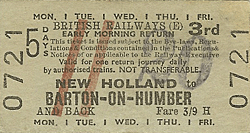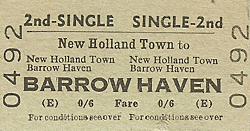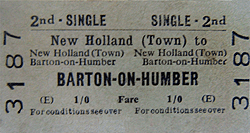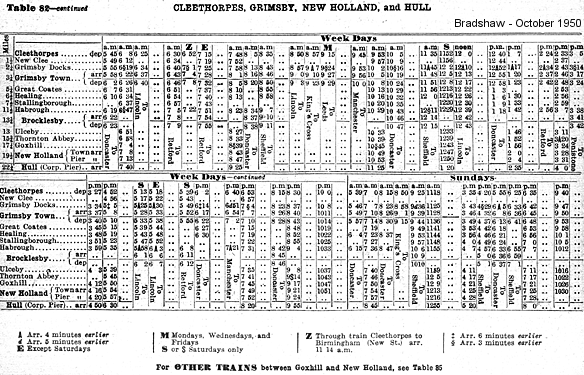Notes: New Holland Town Station was sited at the south end of New Holland Pier; it had two platforms each with substantial brick buildings and canopies. The main entrance and stationmaster's house was on the 'down' side, this later became the 'up' platform on completion of the Great central's extension to Marylebone. By the mid 1960's the 'down' platform building had been taken out of use and the canopy demolished being replaced by a small brick shelter with a short canopy. New Holland Town signalbox was sited at the south end of the 'up' platform.
Until 1948 there was no distinction between New Holland Pier Station and New Holland Town Station in Bradshaw; they were listed as one station, consequently early tickets just show New Holland.
After the opening of the Humber Bridge in June 1981, New Holland Town was replaced by a new station on the Barton on Humber line to the south of the original site and closer to New Holland village. This new station consists of a single wooden platform.
At the south end of New Holland Town station was a brick built four track straight through road shed with a twin gable style roof. There was a water tank at the west entrance to the shed. At some date, possibly early 1920's the shed was completely re-roofed with a Dutch barn style and the two original archway entrances replaced by a single steel lintel. The shed was officially closed on 20 April 1941 but it continued to be used for servicing until 1960. It was demolished in 1965.
BRIEF HISTORY OF NEW HOLLAND PIER & RAILWAY
Before the coming of the ferry, New Holland didn't exist, there was just a creek on the south bank of the Humber opposite Hull. In 1803 a small ferry service was opened from the creek across the Humber to Hull. On the south bank, the terminal consisted of a house and a shed and the ferry operation was in reality |
 |
a front for smuggling goods, especially gin and it was Holland’s Gin that provided the inspiration for a name for the settlement. The name really caught on when the New Holland Proprietors set about operating an improved ferry service. The operation at New Holland expanded rapidly; in 1826 the Yarborough Arms pub was built. A stage coach service began in 1828 but it was with improving the road and buying the Magna Charta ferry in 1832 that mail stage coaches began to use the New Holland ferry.
| New Holland's success as a ferry port came about because of competition in nearby Barton. From 1316 the public authorities had gained the right to operate a ferry from Hull to Barton. In September 1831 Joseph Acland started a rival private ferry and although it lasted only until December he had weakened the more expensive public service. Acland supported the New |
 |
Holland scheme and in 1832 the Magna Charta started three round trips a day with an additional crossing on market days. A horse boat was added for animal transportation. When in 1836 the London Mail coach transferred from Barton to New Holland, New Holland became the preferred crossing point. There had already been principal services to Boston, Lincoln and Nottingham although with good turnpikes available, freight traffic stayed on the waterways until the coming of the railway.
The Great Grimsby and Sheffield Junction railway were the first to propose a line to New Holland but before their plans came to fruition they had amalgamated with the Manchester, Sheffield and Lincolnshire Railway (later to become the Great Central).
 |
In 1845 the directors of the Great Grimsby and Sheffield Junction Railway paid £10,000 for the Barrow and New Holland ferries, the jetty, the Yarborough Arms and many off the other facilities. Nine months later they sold everything to the MS&L for £21,000 which caused a scandal. The collapsed reputation of George Hudson, the 'Railway King', led |
to enquiries into the railway financing, and the MS&L was known as the 'Money, Sunk and Lost'.
Between New Holland, Lincoln and Grimsby the fabric of the lines was built for £36,000 and the line to New Holland was opened on 1st March 1848. The M&SL had a good working relationship with the Great Northern. The New Holland - Grimsby line opened on the same day as the GNR's first line, that from Grimsby to Louth. The MS&L allowed the GNR to run trains over its line in return for reciprocal running powers to Louth so the first service ran from New Holland - Louth.
From the beginning, the trains went along the 1375 feet long New Holland pier built by John Fowler, it had two tracks, a carriageway and a footpath and a year later passengers disembarked on to the floating pontoon that eased the passage on to the ferries. Goods now transferred from waterways to the railways and passengers and mail came from the stage coaches.
In the same year 1848, a Bill was proposed which could have had far-reaching consequences for railways in the area. This provided for a tunnel under the Humber, connecting with the railway lines on both the north and south banks. Although passed by the House of Commons, the Bill was rejected by the Lords.
| New Holland was in reality two stations, New Holland Town was sited at the landward end of New Holland Pier while at the pier head was the second station known as New Holland Pier. As one of the early aims of the MS&L was to reach Hull the pierhead at New Holland became its 'Up' terminus. This was later changed to Grimsby on completion of |
 |
their 'London Extension' to Marylebone.
Although there were two stations they were not listed as separate stations in the Railway Clearing House handbook until 1904 and Bradshaw didn't recognise them as separate stations until May 1945, many tickets just refer to New Holland. On 1st March 1849 a branch opened from a junction south of New Holland Town Station to Barton on Humber and in 1910 a branch opened from Goxhill one station south of New Holland to Immingham Dock, both branches were provided with a service from New Holland.
The initial service to and from New Holland consisted of five trains daily in each direction, with two each way on Sundays. By 1922 there were 14 daily trains between New Holland & Cleethorpes with 7 on Sundays, 12 daily trains between New Holland and Barton on Humber and 6 daily trains between New Holland and Immingham Dock.
|
New Holland was busy, although it was never the major railway junction that some had foreseen. There was a suggestion of building custom facilities, which would have been a curious development given the smuggling origins of the place. In 1847 the railway company built a school for the railway children, in 1850 it opened a three acre dock and timber yard, |
warehouses, cattle sheds and coal wharves, in 1851 a rebuilt Yarborough Arms was opened. The schoolroom was licensed by the Bishop of Lincoln for services and the church was opened in 1901.
If New Holland began with smuggling and the railway was born in corruption, the railway operation was no better when the Manchester, Sheffield and Lincolnshire Railway fell out with the Great Northern Railway which ran services from Louth. Ferries would sometimes leave just before the Great Northern Trains arrived at New Holland Pier station. Also the library in New Holland was financed by fines on railway employees.
| New Holland was a railway community, the majority of the 80 house being built by the company to house its workers. It played an important part in railway life for it was here that the railway company laundry was situated and special laundry vans brought the soiled washing from the company’s stations, restaurant cars and hotels. Also centred here was the company's |
 |
wagon sheet repair shops, skills used in the repair of sails could be put to a railway use.
In 1922 the original wooden pier was replaced by the present pier the three earlier vessels used on the service across the Humber were replaced by the three paddle-steamers Wingfleld Castle, Tattershall Castle, and Lincoln Castle between 1934 and 1940, these were built to take passengers and cars and a car ramp was provided at the end of the pier to drive cars down to the ferries. By closure of the station the service was operated solely by Sealink’s Farringford, a diesel-powered paddle ferry dating from 1947.
 |
The Branch to Immingham Docks closed in 17th June 1963, an early casualty under the Beeching cuts. In 1969 there was a proposal to close the service between Cleethorpes, New Holland and Barton on Humber but this was rejected by the Minister of Transport although the line between Grimsby & Louth closed from 5th October 1970. With the building of the Humber Bridge and the closure of the Humber Ferry the closure of the station at New Holland Pier came as no surprise. Work on the Humber Bridge, now the world’s largest single-span suspension bridge, began in 1972 and was scheduled for completion in March 1980. In mid-1979, therefore, British Railways Board gave advance notice of its intention to discontinue the service to New Holland Pier Station from the date of opening of the bridge including the withdrawal of passenger train services between New Holland Pier and Barrow Road Junction, and between New Holland Junction and Barton Junction.
 |
The Barton on Humber branch was closed on 1st June 1981 and with the opening of the Humber Bridge on 24th June 1981, New Holland Pier and New Holland Town stations closed at noon on the same day being replaced by a new wooden halt on the Barton branch which was actually slightly close to New Holland village. The Barton on Humber branch reopened at the |
same time with a new bus service taking passengers across the bridge from Barton.
After closure New Holland Pier was taken over by New Holland Bulk Services, who started a grain and animal food import and export business in 1984. New Holland Bulk Services is still rail connected although rarely used, the Barrow Road signalbox to the south of the station still stands.
| In later years New Holland Pier station was in a very dilapidated and run down condition, two of the three lines had been lifted and the line to the pier was operated as a 'temporary long siding' and trains were required to take on a 'pilot' between Oxmarsh Crossing and New Holland Pier. Before closure of the line there was still a regular service, the last BR |
 |
timetable showed ten trains daily in each direction to Grimsby, with four (rising to six in summer) on Sundays. Normal journey time for the l6 miles from Grimsby to New Holland Pier was just under 40 minutes. The ferry service,across the last great waterway in Britain to be bridged, took an additional twenty minutes.
Sources: Railway Magazine, October 1981 and New Holland: 1803 until the Present Day from Pluralist web site. Tickets from Michael Stewart (except 3187 Brian Halford)
See also: Dave's Railpics of Lincolnshire web site for more pictures of New Holland Pier and the Lincolnshire & East Yorkshire Transport Review web site.
See also New Holland Pier station & Hull Corporation Pier |

old11.jpg)
old12.jpg)
old6.jpg)
old14.jpg)
old18.jpg)
old22.jpg)
2.jpg)
5.jpg)












 Home Page
Home Page